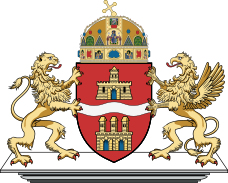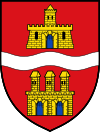Coat of arms of Budapest
This article needs additional citations for verification. (July 2014) |
| Coat of arms of Budapest | |
|---|---|
 | |
| Versions | |
 | |
| Armiger | Capital City of Budapest |
| Adopted | 29 May 1873[1] 30 September 1990[2] (readopted) |
| Crest | Holy Crown of Hungary |
| Supporters | On the dexter a lion Or and on the sinister a griffin Or |
| Compartment | Pedestal |
The coat of arms of Budapest[3] (capital city of Hungary) has existed since 1873, when the three main cities next the Danube river (Buda, Pest and Óbuda) were united in one after existing during a millennium separately. The city committee that was planning the city's unification asked the master-painter Lajos Friedrich that design the coat of arms based in the cities' previous symbols and coats.
Description of the coat of arms
[edit]The coat of arms is composed by two blasons: the superior contains a castle with one tower that represents Pest, as well the inferior a three-towered castle that actually symbolizes Buda (where the Royal Palace of Buda is located).[citation needed] The undulated white stripe in the middle of both blasons represents the Danube river which separates Buda and Pest (passing through the middle of the city). On the top of the coat of arms lies the Crown of the King Saint Stephen, and a two legs standing lion grabs with its protector claws the city symbol on the left side, as a mythological griffin stands on the right side.
History
[edit]After Hungary was invaded by the Soviet armies, soon the coat of arms lost the Holy Crown on it, and was used from 1946 to 1949 without it.[citation needed] Between 1964 and 1990, a new coat of arms was used, avoiding to use the traditional Hungarian symbols that did not match with the communist ideals. After the fall of the Soviet Union, Hungary recovered its independence and in 1990 the original coat of arms created in 1873 was again reestablished.[citation needed]
Gallery
[edit]References
[edit]- ^ a b Czaga 1998, pp. 2–4
- ^ Czaga 1998, p. 7
- ^ Budapest krónikája – a kezdetektől napjainkig., szerkesztette Bart István, Budapest: Corvina Kiadó (2007).
- ^ Czaga 1998, pp. 5–6
- ^ a b Czaga 1998, pp. 6–7
- ^ "6494/1949. – I. számú rendelet. A fővárosi címer használatának megszüntetése". Fővárosi Közlöny (in Hungarian). 60 (37). Budapest: 166. 17 September 1949.
- ^ a b c Berza 1973, p. 207
Bibliography
[edit]- Czaga, Viktória (1998). Nyerges, András (ed.). Budapest arms & colours: throughout the centuries. Budapest: Budapest City Archives. ISBN 963-7323-15-5.
- Berza, László, ed. (1973). Budapest lexikon. Budapest: Akadémiai Kiadó.

![1873–1930[1]](http://upload.wikimedia.org/wikipedia/commons/thumb/4/43/Coa_Hungary_Town_Budapest_big.svg/120px-Coa_Hungary_Town_Budapest_big.svg.png)
![1930–1946[4]](http://upload.wikimedia.org/wikipedia/commons/thumb/2/25/Coat_of_arms_of_Budapest_%281930-1946%29.svg/120px-Coat_of_arms_of_Budapest_%281930-1946%29.svg.png)
![1946–1949[5][6]](http://upload.wikimedia.org/wikipedia/commons/thumb/e/ed/Coat_of_arms_of_Budapest_%281946-1949%29.svg/92px-Coat_of_arms_of_Budapest_%281946-1949%29.svg.png)
![1949–1956[7]](http://upload.wikimedia.org/wikipedia/commons/thumb/c/c5/Coat_of_arms_of_Hungary_%281949-1956%29.svg/101px-Coat_of_arms_of_Hungary_%281949-1956%29.svg.png)
![1956–1957[7]](http://upload.wikimedia.org/wikipedia/commons/thumb/5/5d/Coat_of_arms_of_Hungary_%281946-1949%2C_1956-1957%29.svg/113px-Coat_of_arms_of_Hungary_%281946-1949%2C_1956-1957%29.svg.png)
![1957–1964[7]](http://upload.wikimedia.org/wikipedia/commons/thumb/8/8d/Coat_of_arms_of_Hungary_%281957-1990%29.svg/102px-Coat_of_arms_of_Hungary_%281957-1990%29.svg.png)
![1964–1990[5]](http://upload.wikimedia.org/wikipedia/commons/thumb/7/72/Coa_Hungary_Town_Budapest_%28History%29.svg/92px-Coa_Hungary_Town_Budapest_%28History%29.svg.png)